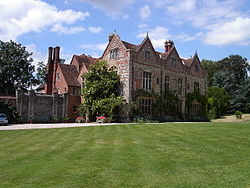Greys Court: Difference between revisions
Created page with "{{Infobox NT |name=Grays Court |county=Oxfordshire |village=Rotherfield Greys |picture=Greys Court.jpg |picture caption=Greys Court |os grid ref=SU725834 |latitude=51.54485 |l..." |
m clean up, replaced: medieval → mediæval (2) |
||
| Line 16: | Line 16: | ||
The name of the house is from an old connection to the Grey family, descendants of the Norman knight Anchetil de Greye. The estate or manor of Rotherfield Greys upon which Greys Court is situated is specifically mentioned in the [[Domesday Book]]. | The name of the house is from an old connection to the Grey family, descendants of the Norman knight Anchetil de Greye. The estate or manor of Rotherfield Greys upon which Greys Court is situated is specifically mentioned in the [[Domesday Book]]. | ||
The mainly Tudor-style house has a courtyard and gardens. The walled gardens contain old-fashioned roses and wisteria, an ornamental vegetable garden, maze (laid to grass with brick paths, dedicated by Archbishop Robert Runcie on 12 October 1981) and ice house. Within the gardens is a | The mainly Tudor-style house has a courtyard and gardens. The walled gardens contain old-fashioned roses and wisteria, an ornamental vegetable garden, maze (laid to grass with brick paths, dedicated by Archbishop Robert Runcie on 12 October 1981) and ice house. Within the gardens is a mediæval fortified tower of 1347, the only remains of the previous castle, overlooking the gardens and surrounding countryside. Also within the gardens is a Tudor wheelhouse, where a donkey operated a treadmill to haul water from a well. | ||
The house is furnished as a family home, with some outstanding 18th-century plasterwork interiors. In 1937 the house was bought by Sir Felix Brunner and his wife Lady Elizabeth Brunner, the granddaughter of the Victorian actor-manager Henry Irving. In 1969 they donated the property to the National Trust, with the family continuing to live in the house until the death of Lady Brunner in 2003. | The house is furnished as a family home, with some outstanding 18th-century plasterwork interiors. In 1937 the house was bought by Sir Felix Brunner and his wife Lady Elizabeth Brunner, the granddaughter of the Victorian actor-manager Henry Irving. In 1969 they donated the property to the National Trust, with the family continuing to live in the house until the death of Lady Brunner in 2003. | ||
Latest revision as of 10:35, 30 January 2021
| Grays Court | |
|
National Trust | |
|---|---|
 Greys Court | |
| Grid reference: | SU725834 |
| Location: | 51°32’41"N, -0°57’21"W |
| Built Tudor | |
| Information | |
| Website: | Greys Court |
Greys Court is a fascinating Tudor country house and associated gardens in Oxfordshire, at the southern end of the Chiltern Hills at Rotherfield Greys, north of Henley-on-Thames. It is owned by the National Trust and is opened to the public.
The name of the house is from an old connection to the Grey family, descendants of the Norman knight Anchetil de Greye. The estate or manor of Rotherfield Greys upon which Greys Court is situated is specifically mentioned in the Domesday Book.
The mainly Tudor-style house has a courtyard and gardens. The walled gardens contain old-fashioned roses and wisteria, an ornamental vegetable garden, maze (laid to grass with brick paths, dedicated by Archbishop Robert Runcie on 12 October 1981) and ice house. Within the gardens is a mediæval fortified tower of 1347, the only remains of the previous castle, overlooking the gardens and surrounding countryside. Also within the gardens is a Tudor wheelhouse, where a donkey operated a treadmill to haul water from a well.
The house is furnished as a family home, with some outstanding 18th-century plasterwork interiors. In 1937 the house was bought by Sir Felix Brunner and his wife Lady Elizabeth Brunner, the granddaughter of the Victorian actor-manager Henry Irving. In 1969 they donated the property to the National Trust, with the family continuing to live in the house until the death of Lady Brunner in 2003.
On television
- Downton Abbey (2012 episode): The house appeared as "Downton Place," a secondary property of the Earl of Grantham.
- Agatha Christie's Poirot (ITV, 2013). In the adaptation of Elephants Can Remember it is used as the home of one of the people Ariadne Oliver visits while investigating the case.
Outside links
| ("Wikimedia Commons" has material about Greys Court) |
- Greys Court - information at the National Trust
- Information from Culture24
- A bird's-eye view of Greys Court Rotherfield Greys in the 17th or 18th century from Scran
- AboutBritain.com information
- TourUK information
- Gardens-Guide information
- Photos of Greys Court, Oxfordshire, petergoodearl.co.uk
- Castles Abbeys and Medieval Buildings information by Michael W. Cook
